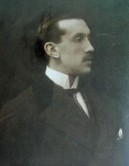
Alberto Martini (Alberto Giacomo Spiridione) was born on November 24th 1876 in Oderzo (Treviso). In 1879 he moved with his family to Treviso, where his father taught design at the Riccati Technical Institute. Between 1890 and 1895 under the guidance of his father, who was described by Vittorio Pica as a unique and caring teacher, he began to paint and draw. During his training Martini produced countless drawings, immediately revealing a predilection for graphics. In 1895 he started his first series of illustrations in pen in ink for the ‘Morgante Maggiore Luigi Pulci’, however, he soon dropped out to devote himself to illustrations for ‘Secchia Rapita’ by Alessandro Tassoni, with which he worked until 1903. In 1896 he started to illustrate a graphic cycle for ‘Il Poema Del Lavoro’ (9 pen drawings in ink). In 1897 he exhibited 14 drawings at the second Venice Biennale for ‘La Corte Dei Miracoli’, which were presented the following year in Monaco and at the International Exhibition of Turin alongside his drawings for ‘Il Poema Del Lavoro’. In 1898 Martini stayed in Monaco and worked as an illustrator for the magazines ‘Dekorative Kunst’ and ‘Jugend’. A pivotal moment in the career of Martini came when he met the artist Vittorio Pica at the International Exhibition of Turin, Pica would go on to support the works of Martini both in Italy and throughout the rest of Europe. In 1901 he executed his first cycle of 19 watercolor pen drawings for the illustrated edition of ‘La Divina Commedia’, commissioned by Alinari of Florence with the intercession of Pica. Following this he participated in the IV Venice Biennale, presenting drawings from ‘La Secchia Rapita’: 38 of these drawings were bought by the Gallery of Modern Art in Rome.
In the summer of 1905 he started to execute display boards for the tales of Edgar Allan Poe, with which he worked up to 1909. In 1912, encouraged by Pica, Martini began to paint, particularly by making use of the technique of pastel. Examples of such work are, ‘Le Sinfonie Del Sole (L ‘Aurora, La Notte, I Fiumi)’ and the pastel, ‘Farfalla Gialla’. At the outbreak of World War I, he made 54 lithographs entitled, ‘Danza Macabra’, through which he revealed his anti-German feelings. These lithographs were then printed in postcard size and distributed among the allies as propaganda against the German empire.
Martini also showed great interest in theatre, creating 84 colour drawings in pen and watercolor and six panels in tempera for the costumes of the ballet, ‘Il Cuore Di Cera’. In 1923, Martini had the idea of the ‘Tetiteatro’: a theatre on the water completely invented and dedicated, as its name suggests, to the sea goddess Thetis. Disappointed and saddened by the hostility of the Italian critics, who in the late twenties seemed to completely ignore his work, Martini moved to Paris where he found friends in high places and many admirers of his art. Whilst in the French capital Martini immersed himself in the environment of critics and writers, befriending Solito de Solis, a musician and art lover who introduced him to the aristocratic salons of Paris. In 1940 Martini was forced to return to Milan due to his precarious financial situation. Here, at the Milan Triennale, he executed the sketch for the triptych, ‘Battaglia d’uomini e Demoni’, then between 1935 and 1936, he revealed his anti-novecentism with his publication in the journal ‘Perseus’ of drawings, captions and cartoons following a biting satirical vein. He died on 8th November, 1954 in Milan, requesting in his will the establishment of a museum to guard the memories and documents of Italian surrealism.



